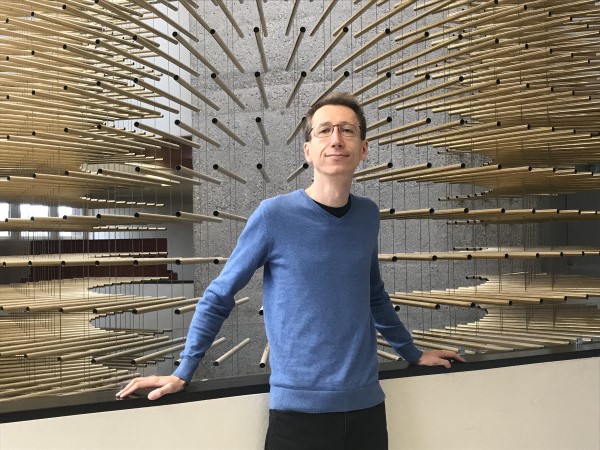Michael Schüler brings spectroscopy experience to merge theory and experiment in NCCR MARVEL's phase III
Interviewed by Carey Sargent, EPFL, NCCR MARVEL
Michael Schüler comes from Halle, a mid-sized university town in eastern Germany where he grew up, went to university and even did his PhD. Afterwards, he moved to Fribourg, Switzerland where he worked as a post-doc in the group of Philipp Werner, professor of Physics at the University of Fribourg. A Humboldt research fellowship then allowed him to spend two and a half years as a postdoc at Stanford University. He has been an "Ambizione" scientist in the Condensed Matter Theory Group at PSI since September 2021.
Have you always been interested in science?
Science has always been something very interesting to me. I have fond memories of my dad building an electrical engine with fridge magnets when I was in primary school. My parents got me a book about little science experiments and I was really fascinated with the many cool experiments.
As I got older, I got a bit geeky and got into programming. Together with my fascination for mathematical thinking — supported by excellent teachers — my interest in science gradually shifted to theoretical and computational physics.
Why are you a scientist? What attracts you to this profession?
A lot of things. Ultimately, you get to play with stuff to figure out new ideas and get to the bottom of unsolved problems. There are so many open questions and I just really like the way we as scientists get to approach this. Certainly, with our thorough education and years of experience we approach questions in a guided way — but still we should not that forget that research should be curiosity driven.
This is something that the school system sometimes tries to streamline a little bit, thinking that everything has to be efficient, but, in the end, we should also not forget that you need creativity and a bit of a playful approach to make discoveries.
And, of course, the other big aspect that I really appreciate is just how communicative that actually is. This is maybe something that is not so well known by the general public – we actually meet a lot, talk to people to exchange ideas. It’s very open and I find that really inspiring.

Photo credit: Sydney Schueler
What is the aim of your research?
What I’m really interested in is trying to bridge this gap between theory and experiments in materials research. I’m trying to understand what we can learn from quantum materials by spectroscopy. Quantum materials have many microscopic properties that manifest on macroscopic scale. How and why that happens is often very complicated, in particular because of the many quantum mechanical degrees of freedom.
Spectroscopies can help to disentangle the microscopic properties, if we understand them well enough. Photoemission spectroscopy is one of the most powerful methods. While being an old technique, a detailed understanding of how to connect the measured signal to aspects of the quantum mechanical wave-function in materials has not been possible. This is what we are going to tackle in my group: trying to connect quantum properties and experimental signatures. It’s great that here at PSI we have a lot of facilities like the Swiss Light Source where we can bring experiment and theory together.
Another idea in the field is to disentangle the microscopic degrees of freedom in the time domain. There are many interesting developments related to ultra-fast spectroscopy, with physics related to the Swiss FEL X-ray laser that we have here.
As a more general question, I’m wondering how we can measure microscopic quantum properties in materials that are hidden, not really accessible, but, in a way, we can still think about smart ways to interrogate matter. In particular I think that understanding the implications of quantum geometry — which is fundamental to the way light couples to materials — is something that’s becoming more and more important for material design.
Which papers are you most proud of?
The first paper is the one we did on dichroic angle-resolved photoelectron spectroscopy and Berry curvature. This is the first collaboration where I kind of called the shots. It shows this fundamental link between the Berry curvature (a quantum geometric property) and circular dichroism in photoemission. That’s something that actually inspired other people to do experiments along those lines. (Note: an article discussing this paper can be found here.)
I also like the work on the light-induced topological state in graphene, where we applied the idea of linking Berry curvature and circular dichroism to the ultrafast regime. Engineering the band structure and quantum properties of materials with light is a big idea with countless theoretical proposals, but very few experimental realizations. The reason for this gap is not really understand, but one of the main aspects are interaction effects and scattering between the electrons. With some advances methods to account for such effects, we showed when and how the light-engineered Berry curvature survives and how it could be measured.
What is the appealing thing about working with NCCR MARVEL?
The nice thing about MARVEL is the synergies that we can generate and benefit from. It is a very lively community (even though I’m just starting to integrate in it). It’s really wonderful and I think that with this new Laboratory for Materials Simulations lead by Nicola Marzari at PSI, it will be one of the best spots to exploit these synergies.
What are your hobbies?
I like to explore the outdoors and the mountains in particular. On the weekends I’m usually hiking. I also finally get to ride on my mountain bike again (I had to leave it when I moved to the U.S.). I also enjoy classical music a lot. My wife is a violinist, so I get regular home concerts.
Low-volume newsletters, targeted to the scientific and industrial communities.
Subscribe to our newsletter